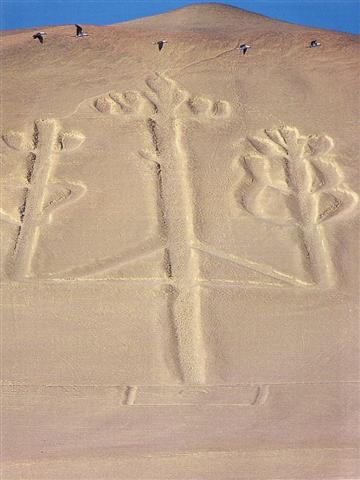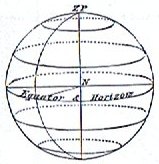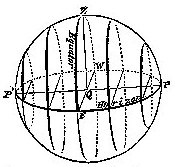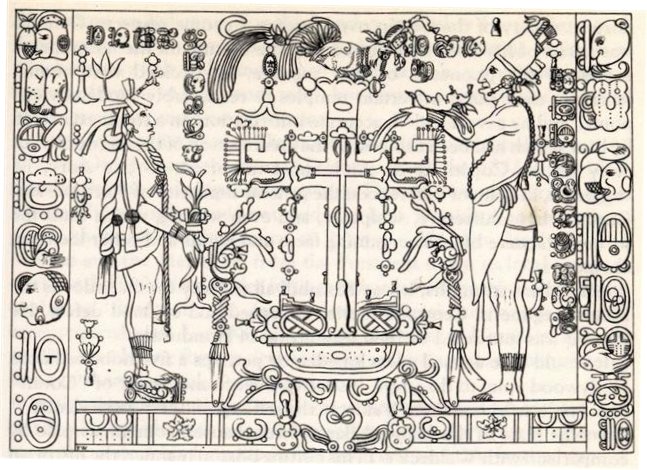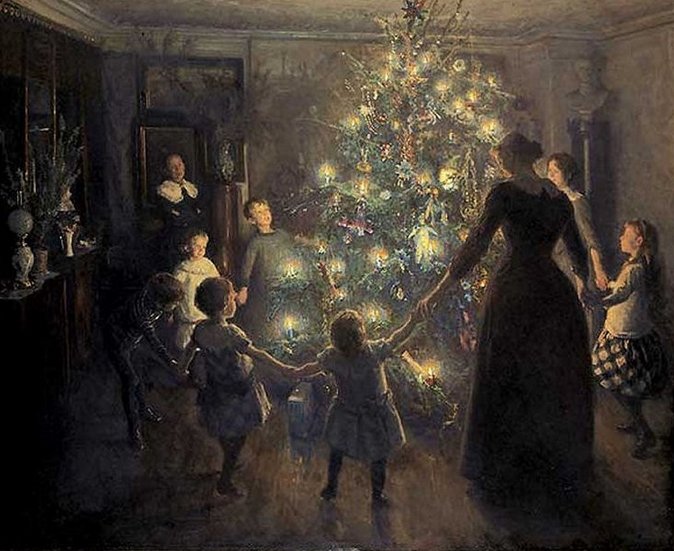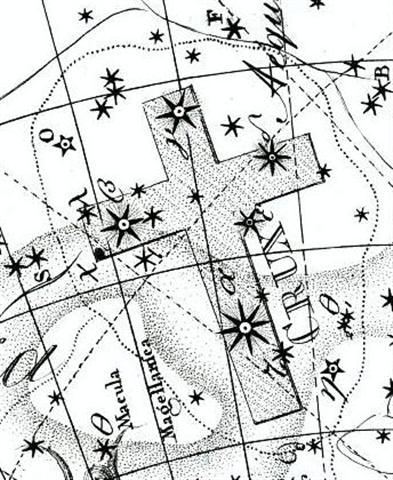149. The Hole for the Cosmic Tree, if this was visualized in the Candelabra of the Andes,
appears not to be 50 days earlier than the Tree itself but located precisely where the Tree was standing. However, this could be due simply to our habit of perceiving such 'cosmic trees', we who live far up in the north:
... This type of fundamental difference in world view will program minds, and I remember reading that the Chinese kept constructing their mills with a horizontal axle instead of with a vertical axle, as the Europeans they were in contact with tried to pursuade them to do ... Polynesians and other peoples living close to the equator (evidently including also the ancient Chinese) instead saw how the vertical dimension in the night sky clearly was measuring out 'longitude' (right ascension) and not 'latitude' (declination). The 'canopy' of such a 'tree' in the night sky should rise in the east before its trunk and root would appear, when the tree was gradually moving into view at the horizon in the east - when it was 'standing up' through its hole of entrance. ... According to an etiological Hawaiian myth, the breadfruit originated from the sacrifice of the war god Ku. After deciding to live secretly among mortals as a farmer, Ku married and had children. He and his family lived happily until a famine seized their island. When he could no longer bear to watch his children suffer, Ku told his wife that he could deliver them from starvation, but to do so he would have to leave them. Reluctantly, she agreed, and at her word, Ku descended into the ground right where he had stood until only the top of his head was visible. His family waited around the spot he had last been, day and night watering it with their tears until suddenly a small green shoot appeared where Ku had stood. Quickly, the shoot grew into a tall and leafy tree that was laden with heavy breadfruits that Ku's family and neighbours gratefully ate, joyfully saved from starvation ... This tree would have been like a cross with its trunk at the equator and with its horizontal 'beam' stretching from one hemisphere to the other. ... 'fire' is actually a great circle reaching from the North Pole of the celestial sphere to its South Pole ...
Perhaps the Candelabra of the Andes illustrated also the pair of parallel lines which outlined the limits of the Sun at the solstices, viz. where new fire was created. The Southern Cross was visible just above the Candelabra of the Andes, which suggests it was rising immediately before the Candelabra. ... 'Two thousand miles of empty ocean and the deeps of the Chile Basin separate Easter Island from the west coast of South America. A due-east course would lead voyagers from the island to make landfall in Chile. But a course somewhat to the north of east might bring a ship eventually to the safe haven of the bay of Paracas in Peru, which lies on a meridian exactly 180 degrees of longitude east - and west - of the temples of Angkor in Cambodia. We came across the water from the north in a small open boat, skirting the arid Balestas islands, now a marine sanctuary, and heading for the Paracas peninsula, where rolling sandstone hills and escarpments drop steeply into the sea. From more than 15 kilometers off-shore we had been able to make out the so-called 'Candelabra of the Andes', first through binoculars and then in direct sight. It lay due south of us, carved into a sloping cliff, looming ever larger in our field of view as we approached. The scholarly consesus is that this huge earth-diagram could easily be 2000 years old and is most likely to have been the work of the same people who created the better-known Nazca lines which are found inland, some 300 kilometers to the south. This 'Nazca culture', about which very little is known, is thought to have flourished from the second century BC until about 600 AD. The 'Candelabra' has a rectangular, box-like base, enclosing a circle, out of which rises the representation of a wide central vertical bar, more than 240 meters in length, running north to south. This is crossed, about one-third of the way up, by a triangular contraption running east to west for some 120 meters, supporting two shorter vertical bars. All three bars are surmounted by curious patterns generally interpreted as flames or rays of light. Because of its auspicious geodetic location half-way round the world from Angkor and 108 degrees west of Giza - sites that both 'resemble the sky' by modelling specific constellations on the ground - we have naturally considered the possibility that the Candelabra could be a work of celestial imitation. What particularly invites this enquiry is the orientation of the diagram. It is set very closely to true north-south, the meridian of the sky, the great dividing-line across which astronomers in all cultures have traditionally observed the 'transits' of stars. The Candelabra was intended by its designers to be seen from the north. Indeed, there is no other perspective from which it may be satisfactorily viewed: the observer must face south towards the sloping escarpment on which it is carved. Examining the diagram from the base up naturally draws the eyes towards the southern sky above the escarpment, and specifically towards the south meridian. Although it may be entirely coincidental, computer simulations tell us that at around the hour of midnight on the March equinox 2000 years ago - the epoch in which the Candelabra was probably made - the constellation known as Crux (the Southern Cross) would have been seen lying on the south meridian at an altitude of 52 degrees. At that moment an observer positioned on a boat as we now were, about a kilometre north of the Candelabra, would have seen the Southern Cross suspended in the sky directly above the great cliff diagram ... At the time of Betelgeuze the Southern Cross would have risen with the Sun about a week after the solstice. ... At the time of Betelgeuze (when this star had been at 0h) Acrux (†) would have risen with the Sun *88 (= the right ascension position of Betelgeuze at the time of rongorongo) days earlier in the year than at the time of rongorongo. September 24 (267, heliacal Acrux) - 88 = 179 (= 80 + 99 = 84 + 95), and this was a week after the solstice when the Sun 'died', † ...
Beyond a solstice life (Sun light) would return and notably Mimosa (β Crucis) was there (5 days after Acrux) as a reminder:
However, the Polynesians living on the Gilbert islands saw another Tree in the night sky, another 'candelabra' with Antares in the east, with the Pleiades in the west, and with Rigel in the middle:
135 (Tau-ono) + 365 - 329 (Ana-mua) = 500 - 329 = 171 (June 20) = 158 (Rigel) + 13. But in a way rising and setting were 183 days apart, and 135 (Tau-ono) + 183 - 329 (Ana-mua) = 318 - 329 = 354 - 365:
I have deduced the day for the culmination (at 21h) of Rigel to be that of Betelgeuze (in January 29) minus the 10-day difference in right ascension (=*88 - *78).
|
